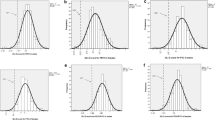Abstract
Purpose
The aim of this study was to compare the differences between three most commonly used predictive equations (PE): ECCS (European Community of Coal and Steel), the third National Health and Nutrition Examination Survey (NHANES III), and GLI (Global Lung Initiative) in healthy individuals and when grading severity of lung function impairment in patients with obstructive lung diseases.
Methods
The study included 200 healthy volunteers and 200 patients with obstructive lung diseases at the Institute for Pulmonary Diseases of Vojvodina. In all subjects, we calculated the absolute and relative (percent) predicted values using ECCS, NHANES III, and GLI reference equations.
Results
The mean differences between ECCS and NHANES III predicted values were 5.63% (95% CI 5.29–5.98%, p < 0.001) for FEV1 and 10% (95% CI 9.52–10.79%, p < 0.001) for FVC. Similar differences were observed between ECCS and GLI predicted values. There were minimal differences between NHANES III and GLI predictive values. In healthy subjects, the mean absolute difference between measured FEV1 and FEV1 ECCS predicted was 0.36l (95% CI 0.32l, 0.40l, p < 0.001), FEV1 NHANES predicted was 0.30 l (95% CI 0.27–0.35l, p < 0.001), and FEV1 GLI predicted was 0.31l (95% CI 0.27– 0.35l, p < 0.001). The use of three different PE leads to significant differences in classification of obstruction severity in both asthma and COPD patients.
Conclusions
There were significant differences between FEV1 and FVC predicted when using different PE. The absolute difference between actual and predicted FEV1 in healthy individuals was highest when using ECCS. The use of different PE may change the interpretation of severity of airway obstruction.
Similar content being viewed by others
References
From the Global strategy for the diagnosis, management and prevention of COPD, global initiative for chronic obstructive lung disease (GOLD) 2017. http://goldcopd.org
From the Global strategy for asthma management and prevention, Global Initiative for Asthma (GINA) 2017. http://ginasthma.org
Miller MR (2005) Standardisation of spirometry. Eur Respir J 26(2):319–338
Stanojevic S, Quanjer P, Miller MR, Stocks J (2013) The global lung function initiative: dispelling some myths of lung function test interpretation. Breathe 9(6):462–474
Stanojevic S, Wade A, Stocks J (2010) Reference values for lung function: past, present and future. Eur Respir J 36(1):12–19
Quanjer PH, Tammeling GJ, Cotes JE, Pedersen OF, Peslin R, Yernault JC (1993) Lung volumes and forced ventilatory flows. Report working party standardization of lung function tests, European Community for Steel and Coal. Official statement of the European Respiratory Society. Eur Respir J Suppl 16:5–40
Hankinson JL, Odencrantz JR, Fedan KB (1999) Spirometric reference values from a sample of the general U.S. population. Am J Respir Crit Care Med 159(1):179–187
Quanjer PH, Stanojevic S, Cole TJ, Baur X, Hall GL, Culver BH et al (2012) Multi-ethnic reference values for spirometry for the 3–95 year age range: the global lung function 2012 equations. Eur Respir J 40(6):1324–1343
Goldman MD, Smith HJ, Ulmer WT (2005) Whole-body plethysmography. Eur Respir Monogr 31:15
Wilcox P, Road J, Altalag A (2009) Pulmonary function tests in clinical practice. Springer, London
Smith HJ, Reinhold P, Goldman MD (2005) Forced oscillation technique and impulse oscillometry. Eur Respir Monogr 31:72
Quanjer PH, Brazzale DJ, Boros PW, Pretto JJ (2013) Implications of adopting the global lungs initiative 2012 all-age reference equations for spirometry. Eur Respir J 42(4):1046–1054
Riffenburgh RH (2006) Statistics in medicine, 2nd edn. Elsevier Academic Press, Waltham
Altman DG (1991) Practical statistics for medical research. Chapman and Hall, London
Reference values for spirometry. http://www.spirxpert.com/gli_ref_values.html. Accessed 30 Mar 2017
Kuster SP, Kuster D, Schindler C, Rochat MK, Braun J, Held L et al (2008) Reference equations for lung function screening of healthy never-smoking adults aged 18–80 years. Eur Respir J 31(4):860–868
Marek W, Marek E, Mückenhoff K, Smith H-J, Kotschy-Lang N, KohlMäufl M (2011) Lung function in our aging population. Eur J Med Res 16(3):108–114
Iglesias I, Benavides M, Delgado YP, Mir I, Rovira S, Torrent A et al (2014) Validation of the global lung function initiative (GLI) spirometry reference equations in school age Spanish children. Eur Respir J 44(Suppl 58):P4519
Quanjer PH, Weiner DJ (2014) Interpretative consequences of adopting the global lungs 2012 reference equations for spirometry for children and adolescents. Pediatr Pulmonol 2:118–125
Hall GL, Thompson BR, Stanojevic S, Abramson MJ, Beasley R, Coates A et al (2012) The global lung initiative 2012 reference values reflect contemporary Australasian spirometry. Respirology 17(7):1150–1151
Bonner R, Lum S, Stocks J, Kirkby J, Wade A, Sonnappa S (2013) Applicability of the global lung function spirometry equations in contemporary multiethnic children. Am J Respir Crit Care Med 188(4):515–516
Linares-Perdomo O, Hegewald M, Collingridge DS, Blagev D, Jensen RL, Hankinson J et al (2016) Comparison of NHANES III and ERS/GLI 12 for airway obstruction classification and severity. Eur Respir J 48(1):133–141
Sood A, Dawson BK, Henkle JQ, Hopkins-Price P, Qualls C (2007) Effect of change of reference standard to NHANES III on interpretation of spirometric “abnormality”. Int J Chron Obstruct Pulmon Dis 2(3):361–367
Author information
Authors and Affiliations
Corresponding author
Ethics declarations
Conflict of interest
The authors declare that they have no conflict of interest.
Ethical Approval
All procedures performed in studies involving human participants were in accordance with the ethical standards of the institutional and/or national research committee and with the 1964 Helsinki declaration and its later amendments or comparable ethical standards.
Rights and permissions
About this article
Cite this article
Vukoja, M., Bokan, A., Vujasinovic, G. et al. The Differences in Spirometry Predictive Equations in Classifying Presence and Degree of Lung Function Impairment: Which Suit Fits the Best?. Lung 196, 87–92 (2018). https://doi.org/10.1007/s00408-017-0065-7
Received:
Accepted:
Published:
Issue Date:
DOI: https://doi.org/10.1007/s00408-017-0065-7




